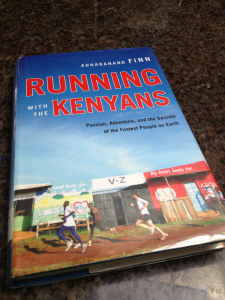As a late bloomer to running, I’m always on the lookout for tips and tricks to improve and accelerate my learning and happen to see this book at the local bookstore.. Running with the Kenyans is written by Adharanand Finn, a journalist and a freelance writer who traveled to Kenya to learn from the runners there and to improve his own running. I think the part that piqued my interest was Finn’s belief in barefoot running style which I talk about quite a bit in my own book Unlearning to Run. After a little over a year of running, I’m a huge believer that the style of running matters more than what shoes you wear.
Running with the Kenyans
Running with the Kenyans is a very different book, compared to Born to Run. While I’m a huge fan of the latter, Finn’s story is on a much more personal level and focuses on his own progress as he trains with the Kenyan runners to run a sub 3:00 marathon. One thing that comes across loud and clear is the dedication of the Kenyan runners to the sport. While Finn, and many others before him, have searched for specific secrets that can be replicated, he goes on to find that it’s not a simple list after all. It’s a combination of how even at a young age, these kids run 6 miles to school and back everyday. It’s the hope and aspiration to excel in a sport, which of course can be financially rewarding. In some ways running in Iten, Kenya is the equivalent of startups in Silicon Valley. Many shattered dreams, but there’s always hope that with enough perseverance there’s a chance to change the world and make it big.
The magic discovered through running with the Kenyans is not a simple recipe (emphasis mine): it’s the tough, active childhood, the barefoot running, the altitude, the diet, the role models, the simple approach to training, the running camps, the focus and dedication, the desire to succeed, to change their lives, the expectation that they can win, the mental toughness, the lack of alternatives, the abundance of trails to train on, the time spent resting, the running to school, the all-pervasive running culture and finally the reverence for running.
A curious thing that I did pick up from this book were the striking similarities between Ugali (corn meal mush served with Kale stew), the staple food of these Kenyan runners and Pinole the staple food of the Tarahumara. The fact that they are both corn-based and the runners usually stick to eating just this most of their time is to me very interesting, nutritionally. Fauja Singh, the 101 year old marathoner is also known to have a fairly strict, but narrow vegetarian diet. And just today, I read about Mike Freemont, 91, who finished the Knoxville Half Marathon in 3:04 and has been a vegan since turning 69 (after he was diagnosed of cancer).
A couple of other interesting learnings: I tried the 25-1-1 interval training method from the book and was blown away by the simplicity and efficiency of it. This is effectively repeating 1-minute of slow jogging followed by 1-minute of faster paced running, 25 times. Using the watch just as a reminder as opposed to actively logging miles was the other one. I’ve been subconsciously doing this by eschewing Strava or other Apps to actively record my mileage. I’ve noticed that actively recording my runs (all the time) was distracting me from having fun.
Overall, I enjoyed reading about Finn’s adventures in Kenya, his training and attitude towards barefoot running style and how he made a positive impact with the other runners there. Check out the Running with the Kenyans Facebook page and you can also follow him on Twitter.
Have you read this book? What did you think of it?
[sc:follow_me ]